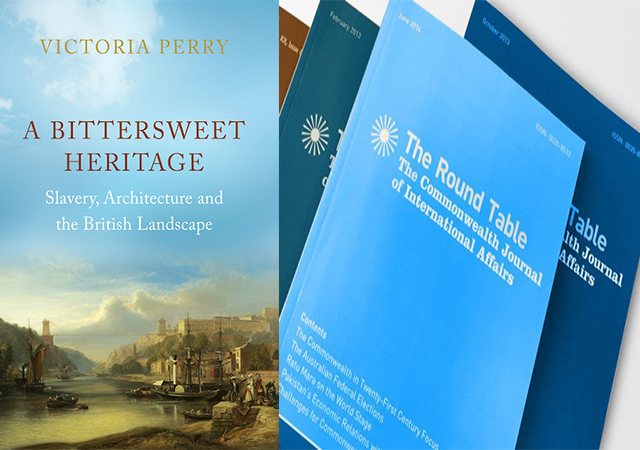
[This is an excerpt from an article in The Round Table: The Commonwealth Journal of International Affairs.]
For too long, many of the great country houses of Britain as well as the landscapes created to set them off, were viewed as essential evidence of the development of the architectural styles, gardening and landscape preferences of the 17th, 18th and 19th centuries. In many accounts, they seemed to float free of the realities of both their economic and global contexts. It might also perhaps be said that wealth generated in India and elsewhere in the East was more likely to be acknowledged than the riches underpinned by slavery in the western hemisphere. Some time ago, I chided the distinguished author of a book on the Glasgow Tobacco Lords for barely mentioning slavery. That author later made handsome amends by becoming one of the leading scholars charting the transfer of slaving and plantation wealth into Scotland. More recently the relationship between slavery and the built heritage of Britain, both urban and rural, has been more comprehensively exposed. The books of Stephanie Barczewski, Madge Dresser and others, as well as work on landownership and transfers and on art patronage have further demonstrated the background of the slave trade and plantation wealth on so many aspects of material and environmental culture.
Commonwealth Bookshelf – The Round Table Journal
Reparations for slavery becomes a Commonwealth issue
‘Sey yuh sorry!’: edgy reception for royal tour of Caribbean Commonwealth states
It is of course no accident that these scholarly developments have accompanied high-profile events in respect of the Black Lives Matter movement, the incidence of statue toppling and the changing of names closely associated with slavery, debates about colonial inheritance and reparations as well as the return of looted artefacts, such as the Benin bronzes, from museums to their proper national origins. These are all very much a matter of on-going controversies and frequently stimulate right-wing opposition to the focus of museums exhibitions and the recognition by the National Trust (for example) of slavery connections to their properties. Uncomfortable truths are perhaps always a problem to those who would rather keep them hidden.
The considerable contribution of this book is to connect the architectural expressions of colonial and slavery wealth in the late 17th and (mainly) 18th centuries to the development of landscape styles. Those who acquired considerable wealth through industry and the labour of poorly paid workers or through slavery and the colonial production of sugar, tobacco and other products, often had a desire to translate such wealth into gentility. Many years ago, the American historian Martin Wiener argued that such a search for gentrification as symbolised by country estates and houses, led to what he saw as the decline of the industrial spirit. Gentrification, in other words, became the non-productive consequence of social ambitions. The argument here, however, is somewhat different namely that slave trade and plantation wealth was in a sense ‘laundered’ in material and environmental ways, thereby developing the environmental styles which emerged from and further promoted concepts of the sublime (even Burke, the exponent of the latter, had his West Indian connections) and the picturesque. The wealthy not only desired grand buildings to symbolise their status, but also pleasure gardens and landscapes, often utilising and enhancing natural features such as river valleys, ravines, cliffs, hills, ruins and so on. Such landscapes became sources of pleasure and visual entertainment not just to private owners, but also to travellers and tourists, initially of course of certain privileged classes. Moreover, invented and artificial environments influenced the development of related artistic styles and tastes as they were transformed in the late 18th century, ultimately infusing the full-blown romantic movement. They also came to be the setting for elite pastimes such as hunting, shooting, and horse riding. All such pleasures were rendered more accessible by the development of turnpike roads, often an additional investment from the same sources of wealth. The turnpikes aided leisure movement (and some economic activity) in the years before the development of canals and railways.
Find out more about the Commonwealth Round Table and the Round Table Journal.
Perry examines these phenomena in contrasting properties such as Danson Park in Bexleyheath in London and the grandiloquent Harewood in Yorkshire. She also closely examines the slavery connections of Bath and the remarkable relationship with the Wye valley of the estate at Piercefield, Monmouthshire. Another of her ‘tainted landscapes’ as she calls them, is around Penrhyn Castle in North Wales. After these illuminatingly detailed chapters, she moves on to a relatively swift examination of some more ‘remote’ locations in the Lake District and Scotland. A notable characteristic of Perry’s work, as she follows these developments through many English, Welsh and Scottish country estates, is to link them to literary expressions in prose and poetry, to furniture and decorative styles (for example, in the use of the opulent tropical hard wood mahogany in doors and panelling) and even, in passing ways, to cuisine and diet. As an architect herself, she is strongly influenced by the contexts and framing of structures. This all makes for an impressive, highly readable, and beautifully illustrated book.
A bittersweet heritage: slavery, architecture and the British landscape by Victoria Perry, London, Hurst, 2022.
John M. MacKenzie is with the University of the Highlands and Islands.



